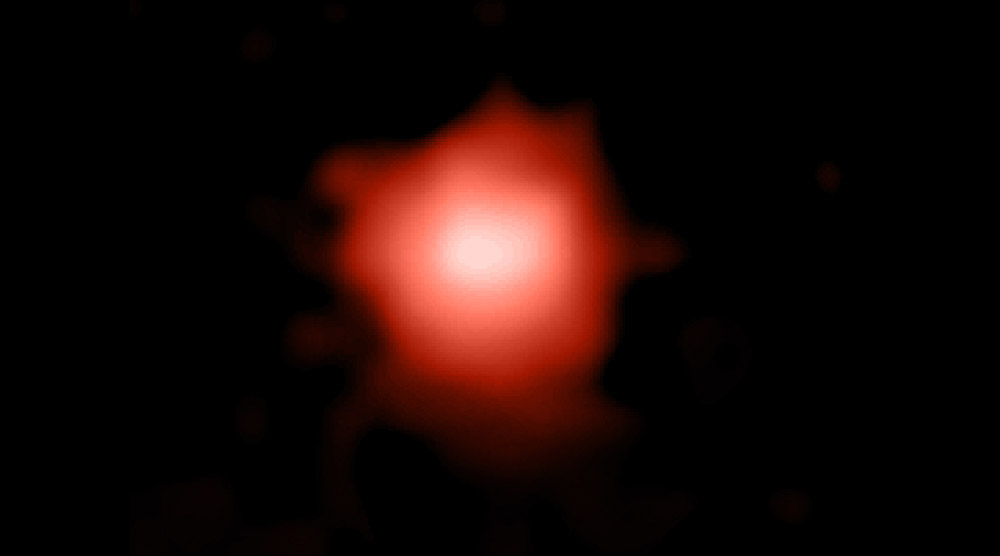Looking back: astronomers have discovered the oldest known galaxy to date – it existed 300 million years after the Big Bang. The star cluster, called GLASS-z13, was small by today’s standards, but already had a very active star formation, as its light spectrum suggests. The new record-breaking galaxy has been discovered in the first images taken by the new James Webb Space Telescope, confirming its potential for astronomical discoveries.
When were the first stars and galaxies formed in the universe? So far, this question has not been answered unequivocally, because only a few telescopes can look far enough into space to make such distant and early objects visible. So astronomers are only aware of a handful of galaxies that are more than 13 billion light-years away. The oldest representatives of these constellations to date are Gn-z11which existed 400 million years after the Big Bang and were only recently discovered Galaxy HD1. It existed 330 million years after the Big Bang, and thus was the first known galaxy to date.
Discovery in the first data from the Webb telescope
But now there’s a new record holder – and the new one has tracked him down James Webb Space Telescope. The near-infrared camera (NIRCam) operates in the near-infrared range from 0.5 to 6 micrometers and thus can accurately capture wavelengths emitted by distant light sources that are strongly redshifted. So one of the main tasks of the telescope is to look back at the time of the first galaxies.
For their study, astronomers led by Rohan Naidoo of the Harvard and Smithsonian Center for Astrophysics took the first “deep-field” data from a telescope to search for bright early galaxies — and found what they were looking for.
Astronomers have discovered two galaxies whose light exhibits a redshift of z = 11 and z = 13.1. The first group of stars, called GLASS-z11, existed 400 million years after the Big Bang. A second galaxy, GLASS-z13, could be the oldest group of stars ever observed: Its stars shined about 300 million years after the Big Bang — making this galaxy another 30 million years older than previous record holder HD1, scientists report astronomy.
Very bright and energetic little creatures
Also exciting: From the light spectrum of the two original galaxies, astronomers have been able to determine more about their size and composition. Accordingly, both galaxies contain about a billion solar masses of stars and have a size of 1,600 and 2,300 light years. Compared to today’s galaxies, it is very small: the Milky Way is more than 170,000 light-years in diameter and contains up to 400 billion stars.
Despite their small size, these early dwarfs of galaxies are indeed very active: they must have released strong ultraviolet rays in their time, indicating intense star formation. Like GNz11, GLASS-z11 and GLASS-z13 belong to the group of luminous galaxies. “This indicates that the early discovery of GN-z11 was not just a happy coincidence, but that there was a whole host of such ultraviolet luminous sources with strong star formation in this early cosmic period,” Naidoo and colleagues say.
early disc
Webb’s images reveal something else: the younger galaxy, GLASS-z11, is less clumpy and turbulent than previously assumed for such early star clusters. Instead, the shape of its spectrum indicates that GLASS-z11 does indeed have the typical elliptical shape of many modern galaxies. “These objects also give us new insights into the morphology of galaxies in this very early era of the universe,” the researchers explain.
Naidoo and his team acknowledge that there are still some uncertainties in the data. “The main limitation is that this data comes from the first extragalactic deep fields provided by the new major observatory,” they wrote. Therefore, some of the systemic uncertainties and sources of error have not yet been examined in more detail. However, the optical signatures of the galaxies were very clearly detectable in all filter channels of the NIRCam. Therefore, astronomers are confident that the basic data is correct.
Telescope ‘Unprecedented Capabilities’
According to the researchers, these first discoveries already demonstrate the potential of the new space telescope: “Our analysis demonstrates the unprecedented ability of the James Webb Space Telescope to provide accurate measurement data for the early galaxies in the universe,” they wrote. So it will be interesting to see what new insights and results additional recordings from this telescope will bring. (The Astrophysical Journal Letters, submitted; arXiv: 2207.09434)
Source: ArXiv

“Prone to fits of apathy. Zombie ninja. Entrepreneur. Organizer. Evil travel aficionado. Coffee practitioner. Beer lover.”







More Stories
A mysterious discovery on Mars – NASA talks about “tire tracks” or “dragon scales”
Bundesbank chief calls for higher growth rates – MarketScreener
“Dragon scales” or “tire tracks” – NASA spacecraft makes a strange discovery on Mars